Got to spend a few days outdoors on the last canoe trip of the year. I was invited to join two buddies to check out the Queen Elizabeth II Wildlands park just a relatively short 1-1/2 hours north of home. ExploreTheBackcountry.com has a detailed topo map of the region, a non-operating park with scatterings of cottages on the main access lakes. The southern end of the park is reached through Head Lake which is locally notorious for its waves given the relatively large surface area and shallow depth. The plan was to travel northeast to the Head River, complete the short 100m portage and continue up into Fishog, then northwest into Round Lake and into Long.
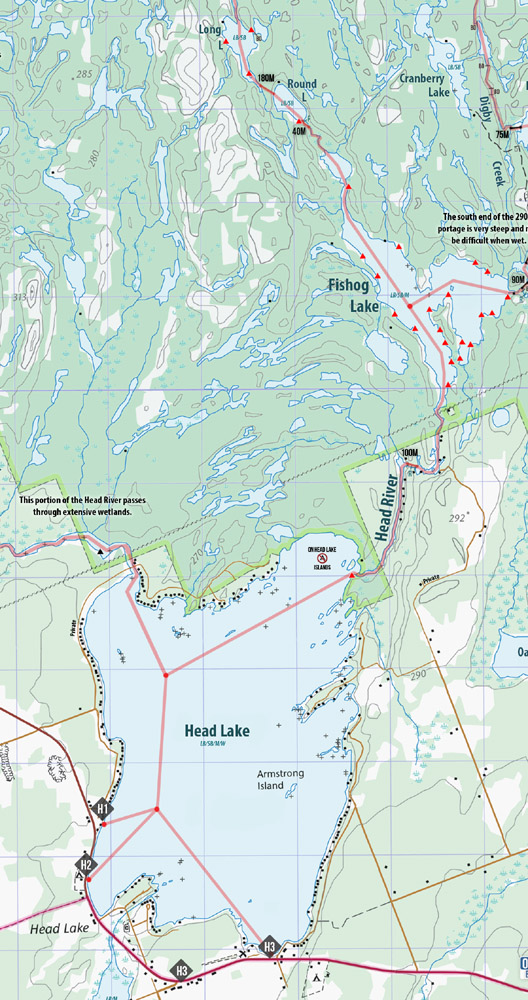
The map marked 3 launch points on the southwestern shore. Just before departing, we learned of a new access point not yet on the map at the Northeastern section past the 100m portage on the Head river. It seemed to be a gift so we wouldn't have to have to cross the width of Head Lake and could easily make it up to Long Lake. Unfortunately once arriving the crew found the road was blocked with a locked gate mentioning that access here closed after October 15th. This despite the fact that the park is open year round without any set operating dates. So with a much delayed start, we eventually made it over to the H1 access point (where there were no parking fees) putting us a roughly 6 km further away from our original intended launch point. My companions were loaded up in a 16footer and I was paddling solo in my 14 ft Chestnut Playmate. My shelter for this trip would be a homemade canvas wall tent with a kni-co trekker wood stove. Along with the wanigan and other cold weather accessories, the canoe was heavily loaded but still very manageable.
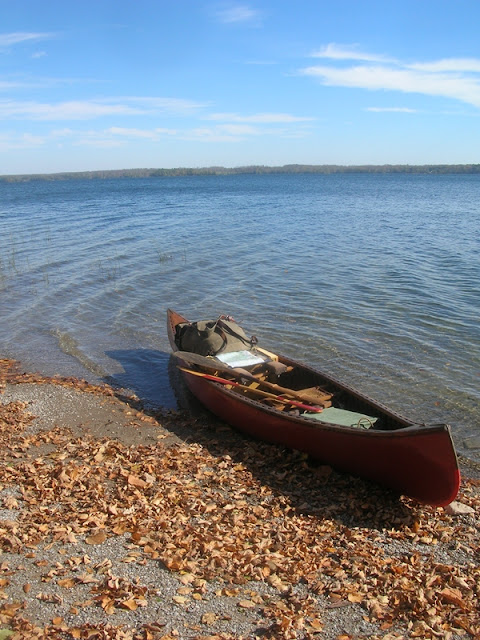
The H1 access point was sheltered so the water conditions looked great. However, once out a few hundred meters, strong winds created some rollers. Luckily with the winds blowing from the Southwest, the journey up to the mouth of the Head River was aided by a near perfect tail wind.
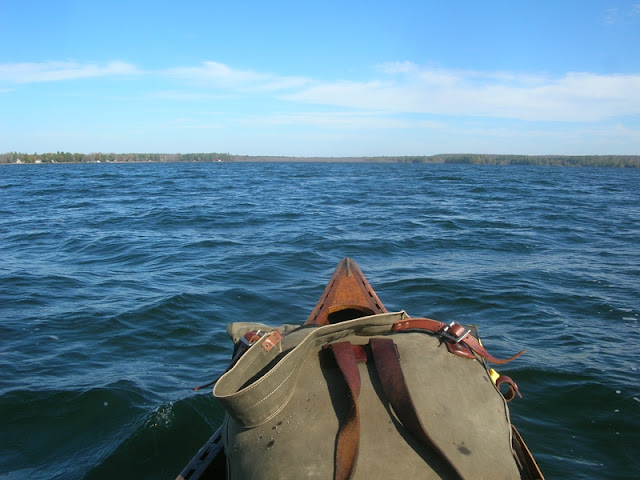
Once around the corner of the bay, the mouth of the Head River was a welcomed wind free picture of solitude.
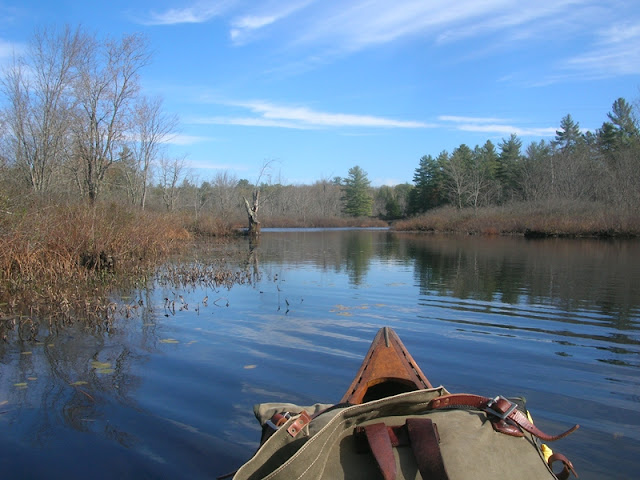
As you can see from the photos, the fall colours were well past peak as most of the leaves had already fallen. A short paddle to the 100m carry around a cascade revealed a very steep portage trail now covered in slippery leaves to contend with in addition to the awkward climb. Given all the gear, this meant triple portages. Despite the short length, the trail was quite technical requiring careful footing. We were well behind schedule given the alternate start point but rushing over this carry was not an option so this slowed the group down considerably.
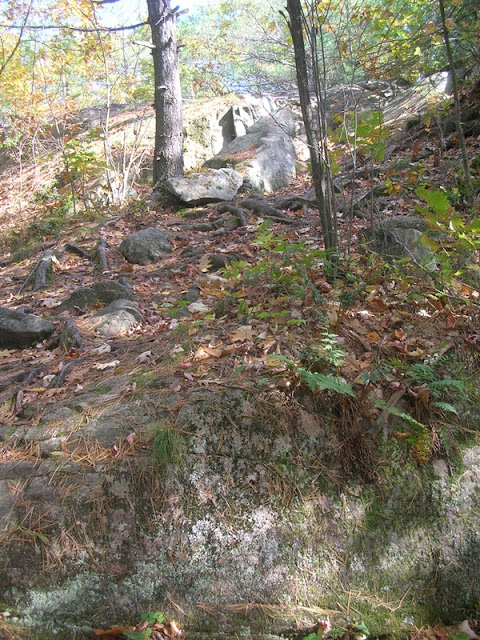
Over on the other side, there was a slight decent to a pool above where someone has a cottage and motorboats. At this point I checked my watch and it was exactly 2 hours since departing from the H1 access point. Had the other new access been open, we would have started further up the Head River and bypassed all of this section and likely would be approaching our destination lake by now.
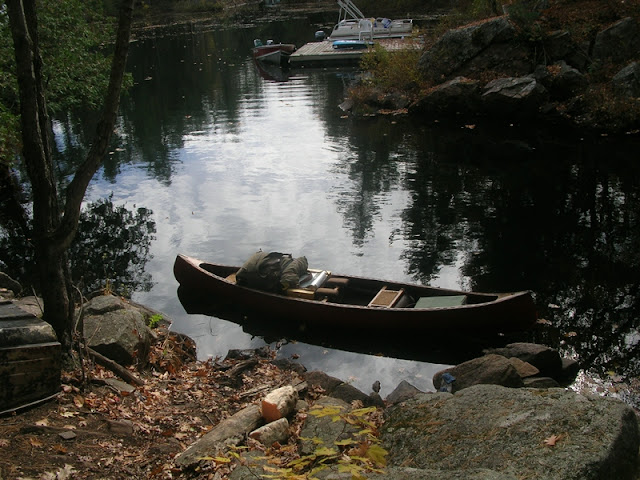
The Head river widens a bit after this point until you eventually enter to park proper. A new sign marking the park boundary has the campsites illustrated on a graphic. Immediately realized there were far fewer campsites listed on the sign than on the topo map. Apparently in an effort to preserve this high use lake, many sites have been closed and camping no longer permitted on them. There are still no fees associated with the park but camping on non-designated sites is prohibited. Hunting is permitted throughout the park after September 14th, so it was a good thing we brought some high visibility orange vests just to be sure.
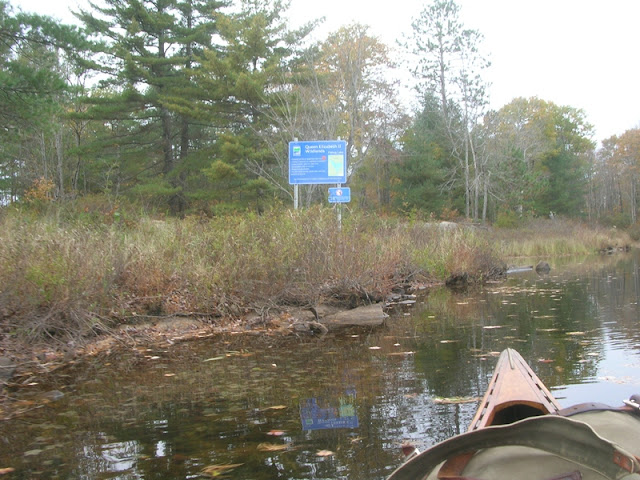
Eventually the narrow channel opens up into Fishog Lake. By this point I was outpaced by the camping friends in a 16 foot tandem so they went ahead to scout out sites.
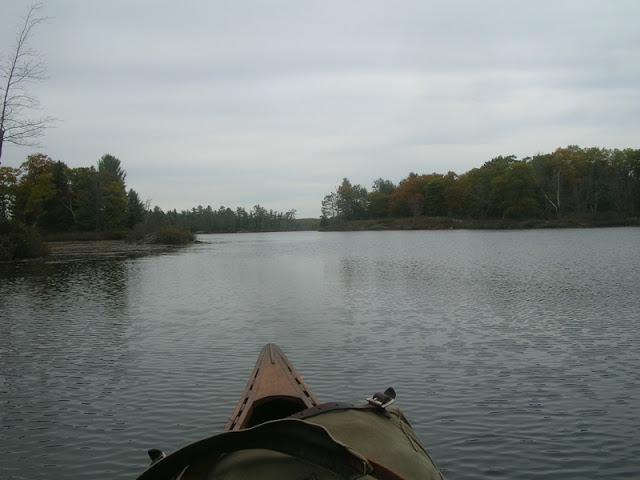
Our sunny skies had faded and rain was seemingly on the way. The shoreline of Fishog still had some remnant leave colour to brighten up and increasingly dreary day.
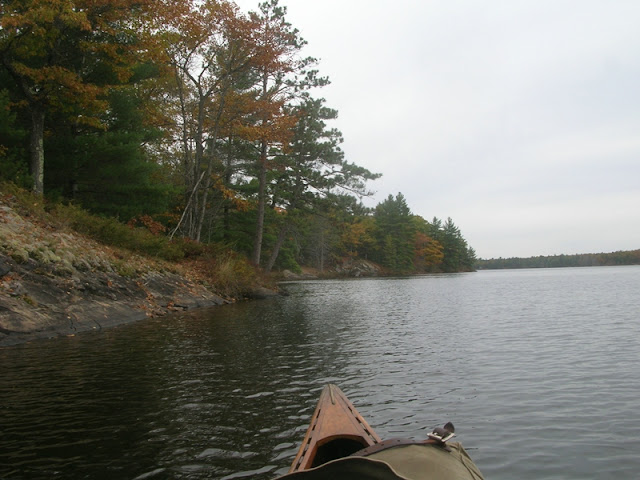
Around halfway up Fishog, the friends had landed on a pretty site at the base of a slope. It seemed well sheltered for the current conditions. Given the fact that we had to spend a large amount of time and effort to cross Head Lake and carry over the and decision was made to camp there instead of trying to get up to Long. Our remaining daylight was beginning to fade so we got to work setting up our individual tents. For this trip, I tried to lighten the load by not bringing the entire pole frame for the canvas tent. Instead the tent was suspended with a tensioned ratchet strap between two well placed trees at the back of the site. A few closet rod poles were carried to support the sides. Rather than scrounge around for wood limbs for the stove pipe support, I used two aluminum shock-corded poles lashed together.
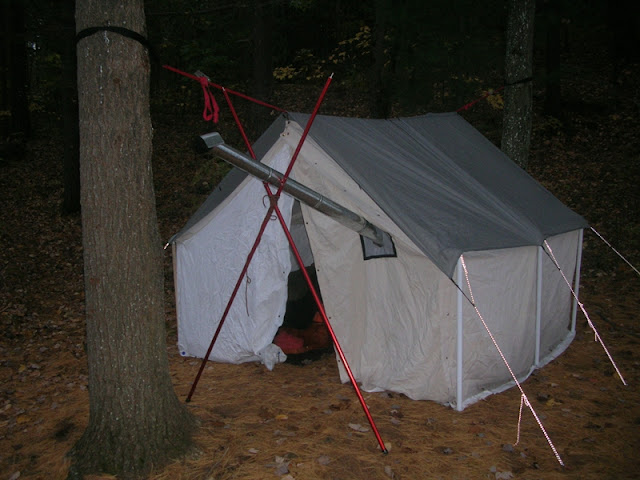
Drizzle and rain persisted during the late evening hours but the tent held up well and stayed dry. I didn't use the woodstove in the tent that first night, but stayed reasonably warm with sleeping bag and wool blanket combo. However, upon waking early to a very chilly morning with a steady northerly wind, the stove was lit to fend off the cold. The stove worked very well. Here's a working shot with the kettle on. A bit smoky when initially lit if the door was open but no worries when the door shut.
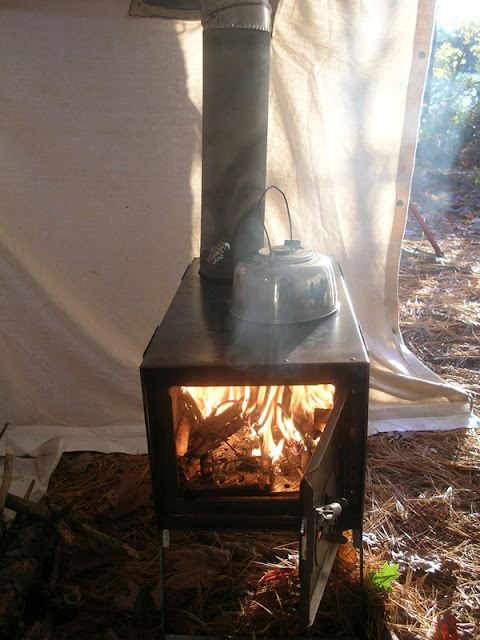
Within a few minutes the whole tent warmed up and felt cozy enough to begin stripping layers. Breakfast was also begun. Before the trip, I came across a youtube vid by Mark Young showing how to make small reflector oven (similar to the famed Svante Freden design) using an aluminum oven liner from the dollar store. Following his directions, I made one that perfectly fit my 6" trangia mini pan. Normally of course a reflector is turned to face the flames of an open fire, but with an elevated pan and the reflector inverted on top of the wood stove, I was able to quickly bake some biscuits to go along with the morning tea.
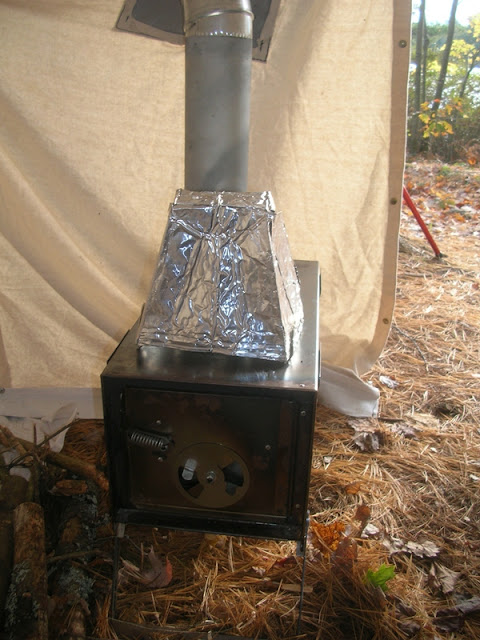
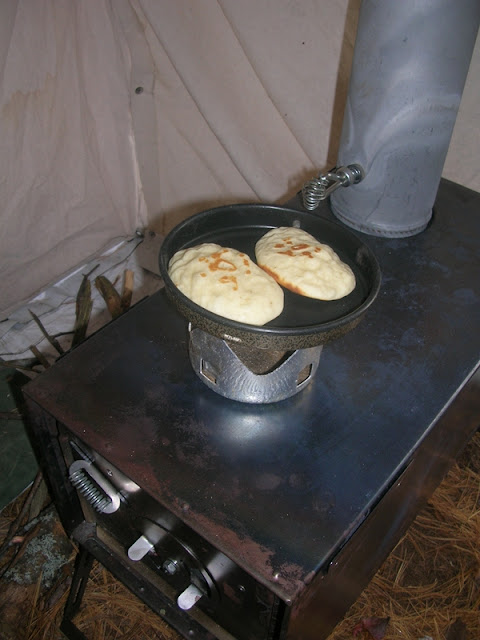
My companions awoke and we were able to spend a relaxing morning warm and sheltered in the tent for the morning meal. Hope that the northerly wind would subside never materialized. In fact, it steadily blew into camp throughout the day. Smoke from the stove pipe was blowing sideways. The lake was too choppy to explore so we were effectively windbound.
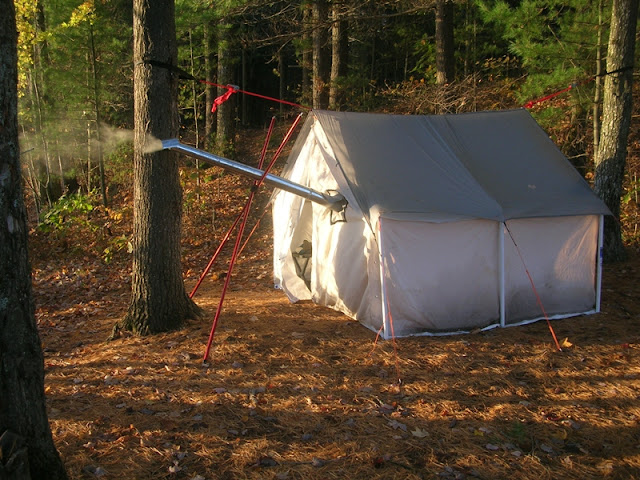
Luckily the sun was shining so after our extended breakfast/brunch we set to work processing some wood both for a hearty evening campfire and for the hot tent. It was enjoyable work sawing and splitting as a group. There was no way I could have processed that much wood on my own during a typical solo trip. One of the members brought along a huge tarp which was promptly setup to form a windbreak by the fire pit.
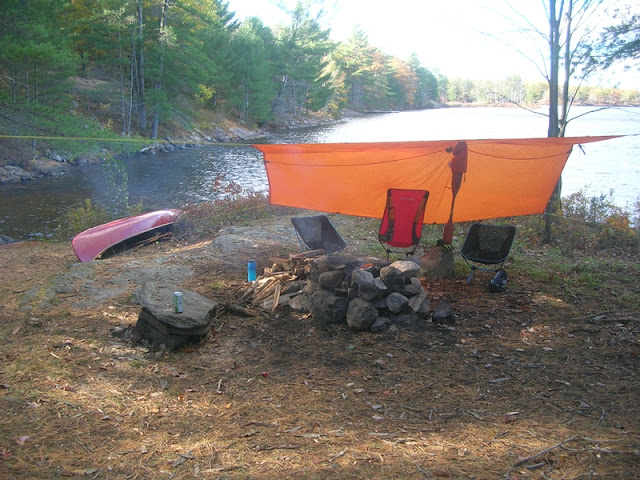
Our evening fire was pretty awesome given all the effort the three of us expended to saw and split so much wood. Much merriment was had, but the evening was extremely cold with the wind. Despite being layered up with thermal underwear, 2 merino wool sweaters, my wool blanket sweater, rain jacket and hi-visibility hunting vest the wind would get to you the moment you stepped away from the fire.
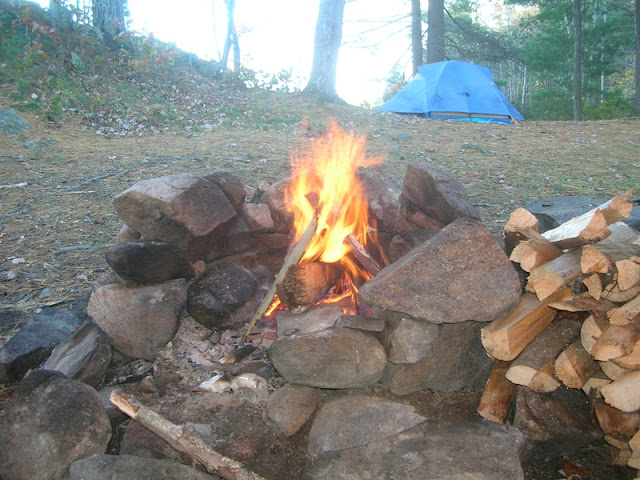
After retiring relatively late that night, I neglected to do one important thing and that was check to see if the guy-lines supporting the wall tent had loosened during the relentless wind all day. I was overly confident that the tent would hold over the night hours given the fact that the tent looked to be fine during the pretty wicked daytime conditions. Planning to read a little before falling asleep, the wood stove was lit to warm up. The stove had begun to die down for the night when I stripped off additional layers and finally crawled into the sleeping bag but hadn't yet fully gotten drowsy. Turned off my headlamp and a few moments later, heard a loud metallic "thonk!". The outer poles on the stove side had collapsed when the wind ripped out all three guylines. Part of the tent (and silnylon tarp) had now collapsed onto the the still hot stove pipe.
Woefully under dressed, I rushed out of the tent (after struggling with a jammed zipper on the sleeping bag) and controlled the flapping tarp and collapsed tent side. It took some creative stretching but in the end I was able to get the material off the stove pipe and reset the guy-lines Unfortunately the damage was done resulting in burn holes in that corner of the tent. More significantly, after being exposed to the chilly wind with minimal clothing I began to seriously shiver once back in the tent. A decision was made to re-light the stove to warm up again. While I was nowhere near hypothermic, it was definitely the coldest I've been in years of tripping. With this mishap and the cold, adrenalin kept me up for most of the night. This time I made sure the stove pipe had completely cooled before getting into bed again. But as I lay there I couldn't help but think that my laziness in checking the guylines before bed was a huge mistake. For future trips with the wood stove I believe bringing along the full interior pole frame would prevent a similar incident from occuring during gusty conditions.
At any rate, the wind continued the next morning with no sign of really slowing down. After breakfast, we all began breaking camp. The full extent of the burn damage at the corner was visible in the daylight. Given the modular design with removable panels, I'm confident my little homemade experimental tent can be repaired so the whole project isn't a write-off. Something to do over the winter, right?
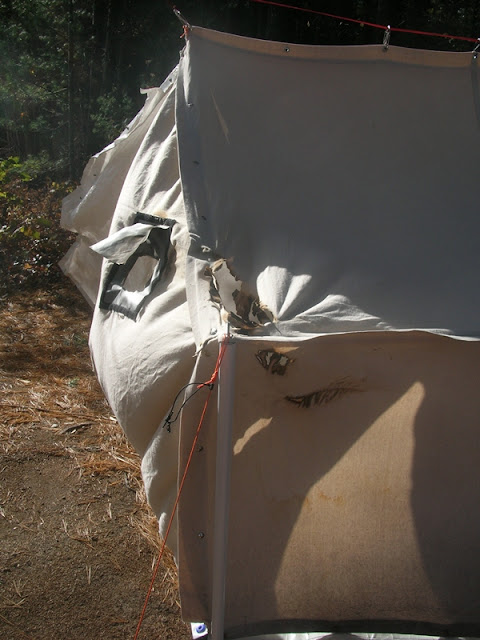
At least it wasn't raining when packing up so the gear was put away dry. After draining the gravity filter, discovered an accumulation of ice at the bottom of the bag. We would later learn that the temperature dropped to zero degrees C but the windchill was -9C.
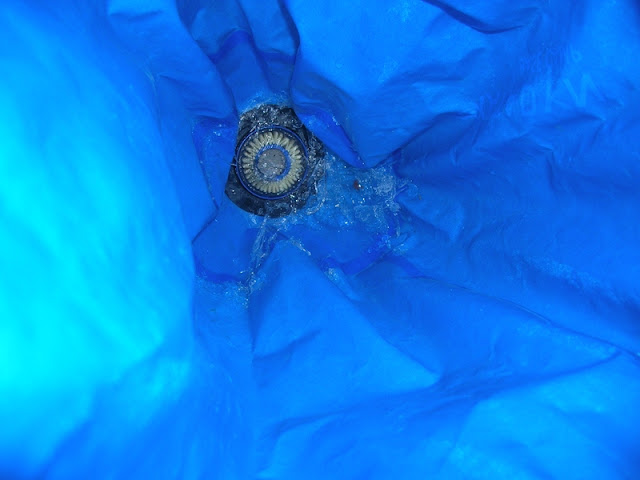 .
.
The wind was still whipping and gusty at departure which made for a tricky return back to the Head lake access point but we all made it back fine. Despite the serious mishap with the tent, it was definitely worth lugging all that extra gear to deal with the chilly conditions. The warmth from the stove was a mood booster and made the outdoor living much more comfortable during the unpredictable autumn conditions. If all goes well, the tent will be repaired over the off season for an early spring trip in 2019.
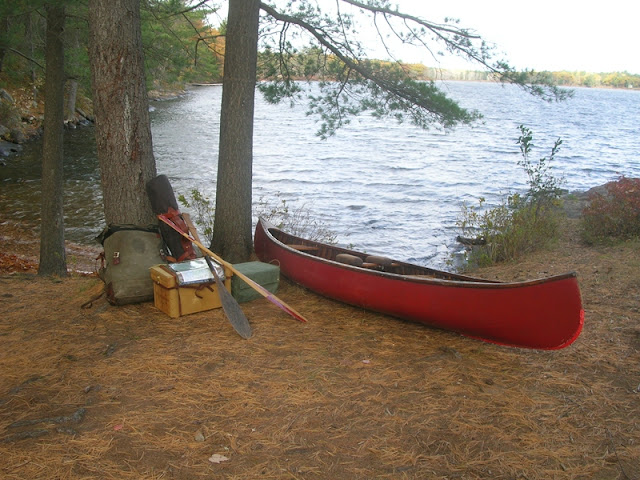

The map marked 3 launch points on the southwestern shore. Just before departing, we learned of a new access point not yet on the map at the Northeastern section past the 100m portage on the Head river. It seemed to be a gift so we wouldn't have to have to cross the width of Head Lake and could easily make it up to Long Lake. Unfortunately once arriving the crew found the road was blocked with a locked gate mentioning that access here closed after October 15th. This despite the fact that the park is open year round without any set operating dates. So with a much delayed start, we eventually made it over to the H1 access point (where there were no parking fees) putting us a roughly 6 km further away from our original intended launch point. My companions were loaded up in a 16footer and I was paddling solo in my 14 ft Chestnut Playmate. My shelter for this trip would be a homemade canvas wall tent with a kni-co trekker wood stove. Along with the wanigan and other cold weather accessories, the canoe was heavily loaded but still very manageable.

The H1 access point was sheltered so the water conditions looked great. However, once out a few hundred meters, strong winds created some rollers. Luckily with the winds blowing from the Southwest, the journey up to the mouth of the Head River was aided by a near perfect tail wind.

Once around the corner of the bay, the mouth of the Head River was a welcomed wind free picture of solitude.

As you can see from the photos, the fall colours were well past peak as most of the leaves had already fallen. A short paddle to the 100m carry around a cascade revealed a very steep portage trail now covered in slippery leaves to contend with in addition to the awkward climb. Given all the gear, this meant triple portages. Despite the short length, the trail was quite technical requiring careful footing. We were well behind schedule given the alternate start point but rushing over this carry was not an option so this slowed the group down considerably.

Over on the other side, there was a slight decent to a pool above where someone has a cottage and motorboats. At this point I checked my watch and it was exactly 2 hours since departing from the H1 access point. Had the other new access been open, we would have started further up the Head River and bypassed all of this section and likely would be approaching our destination lake by now.

The Head river widens a bit after this point until you eventually enter to park proper. A new sign marking the park boundary has the campsites illustrated on a graphic. Immediately realized there were far fewer campsites listed on the sign than on the topo map. Apparently in an effort to preserve this high use lake, many sites have been closed and camping no longer permitted on them. There are still no fees associated with the park but camping on non-designated sites is prohibited. Hunting is permitted throughout the park after September 14th, so it was a good thing we brought some high visibility orange vests just to be sure.

Eventually the narrow channel opens up into Fishog Lake. By this point I was outpaced by the camping friends in a 16 foot tandem so they went ahead to scout out sites.

Our sunny skies had faded and rain was seemingly on the way. The shoreline of Fishog still had some remnant leave colour to brighten up and increasingly dreary day.

Around halfway up Fishog, the friends had landed on a pretty site at the base of a slope. It seemed well sheltered for the current conditions. Given the fact that we had to spend a large amount of time and effort to cross Head Lake and carry over the and decision was made to camp there instead of trying to get up to Long. Our remaining daylight was beginning to fade so we got to work setting up our individual tents. For this trip, I tried to lighten the load by not bringing the entire pole frame for the canvas tent. Instead the tent was suspended with a tensioned ratchet strap between two well placed trees at the back of the site. A few closet rod poles were carried to support the sides. Rather than scrounge around for wood limbs for the stove pipe support, I used two aluminum shock-corded poles lashed together.

Drizzle and rain persisted during the late evening hours but the tent held up well and stayed dry. I didn't use the woodstove in the tent that first night, but stayed reasonably warm with sleeping bag and wool blanket combo. However, upon waking early to a very chilly morning with a steady northerly wind, the stove was lit to fend off the cold. The stove worked very well. Here's a working shot with the kettle on. A bit smoky when initially lit if the door was open but no worries when the door shut.

Within a few minutes the whole tent warmed up and felt cozy enough to begin stripping layers. Breakfast was also begun. Before the trip, I came across a youtube vid by Mark Young showing how to make small reflector oven (similar to the famed Svante Freden design) using an aluminum oven liner from the dollar store. Following his directions, I made one that perfectly fit my 6" trangia mini pan. Normally of course a reflector is turned to face the flames of an open fire, but with an elevated pan and the reflector inverted on top of the wood stove, I was able to quickly bake some biscuits to go along with the morning tea.


My companions awoke and we were able to spend a relaxing morning warm and sheltered in the tent for the morning meal. Hope that the northerly wind would subside never materialized. In fact, it steadily blew into camp throughout the day. Smoke from the stove pipe was blowing sideways. The lake was too choppy to explore so we were effectively windbound.

Luckily the sun was shining so after our extended breakfast/brunch we set to work processing some wood both for a hearty evening campfire and for the hot tent. It was enjoyable work sawing and splitting as a group. There was no way I could have processed that much wood on my own during a typical solo trip. One of the members brought along a huge tarp which was promptly setup to form a windbreak by the fire pit.

Our evening fire was pretty awesome given all the effort the three of us expended to saw and split so much wood. Much merriment was had, but the evening was extremely cold with the wind. Despite being layered up with thermal underwear, 2 merino wool sweaters, my wool blanket sweater, rain jacket and hi-visibility hunting vest the wind would get to you the moment you stepped away from the fire.

After retiring relatively late that night, I neglected to do one important thing and that was check to see if the guy-lines supporting the wall tent had loosened during the relentless wind all day. I was overly confident that the tent would hold over the night hours given the fact that the tent looked to be fine during the pretty wicked daytime conditions. Planning to read a little before falling asleep, the wood stove was lit to warm up. The stove had begun to die down for the night when I stripped off additional layers and finally crawled into the sleeping bag but hadn't yet fully gotten drowsy. Turned off my headlamp and a few moments later, heard a loud metallic "thonk!". The outer poles on the stove side had collapsed when the wind ripped out all three guylines. Part of the tent (and silnylon tarp) had now collapsed onto the the still hot stove pipe.
Woefully under dressed, I rushed out of the tent (after struggling with a jammed zipper on the sleeping bag) and controlled the flapping tarp and collapsed tent side. It took some creative stretching but in the end I was able to get the material off the stove pipe and reset the guy-lines Unfortunately the damage was done resulting in burn holes in that corner of the tent. More significantly, after being exposed to the chilly wind with minimal clothing I began to seriously shiver once back in the tent. A decision was made to re-light the stove to warm up again. While I was nowhere near hypothermic, it was definitely the coldest I've been in years of tripping. With this mishap and the cold, adrenalin kept me up for most of the night. This time I made sure the stove pipe had completely cooled before getting into bed again. But as I lay there I couldn't help but think that my laziness in checking the guylines before bed was a huge mistake. For future trips with the wood stove I believe bringing along the full interior pole frame would prevent a similar incident from occuring during gusty conditions.
At any rate, the wind continued the next morning with no sign of really slowing down. After breakfast, we all began breaking camp. The full extent of the burn damage at the corner was visible in the daylight. Given the modular design with removable panels, I'm confident my little homemade experimental tent can be repaired so the whole project isn't a write-off. Something to do over the winter, right?

At least it wasn't raining when packing up so the gear was put away dry. After draining the gravity filter, discovered an accumulation of ice at the bottom of the bag. We would later learn that the temperature dropped to zero degrees C but the windchill was -9C.

The wind was still whipping and gusty at departure which made for a tricky return back to the Head lake access point but we all made it back fine. Despite the serious mishap with the tent, it was definitely worth lugging all that extra gear to deal with the chilly conditions. The warmth from the stove was a mood booster and made the outdoor living much more comfortable during the unpredictable autumn conditions. If all goes well, the tent will be repaired over the off season for an early spring trip in 2019.

